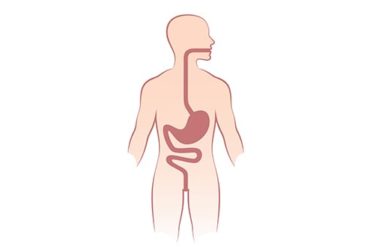There are many stages of the digestion process, beginning at the mouth, and ending with excretion, with each listed in more detail below.
Mouth
Sometimes referred to as the oral cavity, the mouth is where the digestion process begins. Accessory organs such as the teeth, tongue and salivary glands are all involved as food passes through the mouth.
Teeth
The teeth are designed for the purpose of cutting and crushing food into small pieces, ready to be swallowed. There are 32 teeth in the mouth, located along the anterior and lateral edges. Made up of dentin, which is a substance similar to bone, and covered in enamel, the teeth are incredibly hard organs.
The teeth are living organs, containing nerves and blood vessels in the pulp, a soft area underneath the dentin.
Tongue
This small organ consists of several pairs of muscles, with a bumpy, thin, skin-like covering, and performs a number of functions.
Using rough papillae on the outside of the tongue, it grips food and moves it around the mouth, including to the back of the mouth, ready to be swallowed.
The tongue also has taste buds on its surface, which connect to nerves and relay information about the taste to the brain.
Salivary glands
The salivary glands produce saliva, which helps to moisten and lubricate food as it passes down through the various body parts. There are three sets of salivary glands surrounding the mouth, and it is where the digestion of carbohydrates begins.
Pharynx
Also known as the throat, the pharynx performs two different functions, serving both the digestive system and the respiratory system.
The tube, which is shaped like a funnel and connects to the back of the mouth, handles the passing of chewed food as it travels to the esophagus from the mouth.
The pharynx contains the epiglottis, which is a flap of tissue that acts like a switch to direct food to the esophagus, and air to the larynx. This is because air inhaled at the nasal cavity passes through the pharynx to the larynx, as it makes its way to the lungs, and the airway needs to be kept clear of food.
Esophagus
This long, thin, muscular tube is part of the upper GI tract, and connects the stomach to the pharynx, allowing liquid and food to travel along it.
There is a muscular ring at the inferior end of the esophagus, known as the cardiac sphincter, or lower esophageal sphincter. This ring closes the end of the esophagus, trapping food in the stomach.
Stomach
The stomach is a major organ, where food is stored to ensure there is enough time for large meals to be digested properly. It contains digestive enzymes and hydrochloric acid, so food continues to be digested when it is in this muscular sac.
For the average person, their stomach is the same size as when they place their fists together.
Small intestine
This long, thin tube, which is coiled up like a hose, is part of the lower GI tract. The surface inside the small intestine contains many folds and ridges, maximising the absorption of nutrients as food passes through, as well as maximising digestion.
From when the food enters the small intestine, approximately 90 per cent of nutrients will be extracted by the time it leaves the small intestine.
The small intestine is around 3m in length, and 1 inch in diameter, taking up the majority of the space in the abdominal cavity.
Liver/Gallbladder
The liver is the second largest organ, after the skin, weighing in at 3lbs. The primary function of the liver is to produce bile, which is then secreted into the small intestine. There are many other important functions performed by the liver, which includes detoxification.
The gallbladder is situated next to the liver. Once bile has been produced, it is stored in the gallbladder until it is needed. Excess bile can be recycled by the gallbladder and used to help digest meals later on.
Pancreas
The pancreas is behind the stomach and is responsible for secreting digestive enzymes to help nutrients be digested and absorbed in the small intestine. The pancreas also produces important hormones such as insulin, which helps to regulate blood glucose levels.
Large intestine
This long, thick tube is responsible for absorbing water and other absorbable nutrients, as well as converting digested food into feces.
These feces are stored in the rectum, at the end of the large intestine, before exiting the body through the anal canal, a process known as defecation.
The large intestine is around 1.5m long, and 2.5 inches in diameter, and is the final section of the GI tract.



